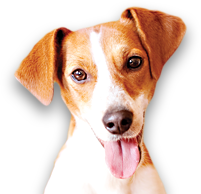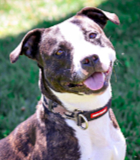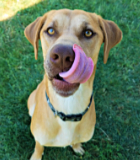Teaching Your Dog to Hand Target
- This topic has 0 replies, 1 voice, and was last updated 14 years, 11 months ago by
Mackenzie’s Admin.
-
AuthorPosts
-
June 17, 2010 at 4:18 pm #539
Mackenzie’s Admin
MemberHand targeting—teaching your dog to touch her nose to your outstretched hand—is a fun, easy training project, and it proves useful in a variety of situations. For example, after you teach your dog to hand target, you can use this skill to guide her onto a scale at the vet’s office, lead her through doorways when she’s nervous, prompt her to jump off of furniture and ask her to hop into your car. You can use hand targeting to teach entertaining tricks, too. Hand targeting is also used in agility, an exciting dog sport that involves directing your dog to navigate obstacles like tunnels and jumps. You can even use hand targeting to help dogs with behavior problems focus on you when they’re feeling afraid, anxious or aggressive.
How to Teach Your Dog to Hand Target Getting Started
First, cut some soft, tasty treats into pea-sized pieces. Choose something that your dog really loves, like soft dog treats, jerky, chicken, hot dogs or cheese. When you’re ready to train, take the treats and your dog to a quiet place.Hold out an open hand in front of your dog, about two inches away from her nose.
Your dog will probably move forward to sniff your hand. The instant you feel her nose touch your palm, say “Yes!” This immediate feedback tells her that the thing she’s doing at that instant is what’s earning her the treat. The better your timing is with the “Yes,” the more quickly your dog will master this exercise.
Immediately feed your dog a tiny treat from the other hand.
Repeat the exercise from the beginning.
If your dog doesn’t touch your extended palm with her nose, keep trying. If you’re patient, she’ll soon catch on. To prompt the first few touches, rub one of the treats on your hand to make it smell more interesting. You can also try moving your hand back and forth in front of your dog’s face—or take your hand away for a couple of seconds and then present it again to grab her attention.When your dog touches your hand 9 out of 10 times in a row, you can start to present your hand in different places. Offer your palm in front of your dog’s nose—but a few inches to the right. Then present your palm a few inches to the left. Then try holding it lower, close to the floor. Present your hand 5 to 10 inches away so that your dog has to stand up and move toward it to make contact. Finally, try holding your palm up above her head so that she has to reach up with her nose to touch it. Always remember to say “Yes!” the instant you feel your dog’s nose make contact with your hand, and then immediately deliver a tasty treat from the other hand. If your dog seems confused at any point, go back to presenting your palm right in front of her nose, just a few inches away, to remind her what to do. If she still seems confused, call it quits for a while. A short break will often improve a dog’s focus.
Aim for training two or three training sessions a day. Your sessions don’t need to be long—less than five minutes is fine. During each training session, present your hand for your dog to target 15 to 30 times. Outside of training sessions, you can also present your hand just once or twice, right before you do something your dog likes. Practice hand targeting before feeding your dog dinner, throwing her favorite ball, taking her on walks and playing with her outside.
Adding a Cue
Once your dog reliably touches your hand when you hold it out to her, you can add a verbal command, or cue. If you have a shy dog and you want to use hand targeting to introduce her to strangers, you can use a cue like “Say hello!” If you plan to use hand targeting in other situations, you can use a word like “Touch,” “Target” or “Here.” Any cue is fine as long as you use it consistently.First, say your cue, “Touch.”
Then extend your palm toward your dog and wait for her to touch it with her nose.
The instant she does, say “Yes!” Then give her a treat from your other hand.
After repeating this exercise for a few sessions, your dog will start to understand what the new cue means. You’ll know she’s got it when you say “Touch” and she immediately approaches you, ready to target your hand as soon as you offer it.Adding Distractions
After a week or two of hand targeting in quiet, calm places, start practicing in more distracting locations. If your dog eagerly touches your palm with her nose as soon as you give the cue and present your hand in any position, you’re ready. (If your dog targets your hand with her nose when you present your hand less than 8 out of 10 times on average, you’ll need to train in a quiet place for a while longer.)The key to success is to increase the level of distraction slowly. At first, practice in slightly more distracting places. For example, instead of practicing in a quiet room, try hand targeting in a busier room while family members talk and walk around. When your dog readily touches your hand as soon as you present it at least 8 out of 10 times in a slightly distracting place, practice in a place that’s a little more distracting, like your backyard at a quiet time of day. When your dog can reliably hand target there, try training at a friend’s house or during walks outside.
As you continue to gradually increase the level of distraction over the next few weeks, make sure that your dog stays successful. If she suddenly seems unable to target your hand when you move to a more distracting location, go back to a less distracting place and practice there a little more. After a few successful sessions, you can try increasing the level of distraction again—just a little.
How to Use Hand Targeting
When your dog can touch your hand on cue—anytime, anywhere—you’ll be able to move her around without having to touch her at all, and you’ll have a fun trick that can be built into many useful behaviors.Use the Dog Magnet
To move your dog onto a scale at the vet clinic, out of the way in crowded areas, off of furniture and into cars, simply use your palm like a magnet. Here’s how it works:Many dogs are a little nervous about stepping onto a cold, slippery scale at the vet clinic. To overcome this problem, walk up to the scale with your dog. Say the cue, “Touch,” and then hold out your open hand.
Your dog will move toward your palm to touch it with her nose. As she does, start to move your palm toward the scale. She’ll follow your hand, just like a magnet, and you can use it to guide her into position. When all four of her feet are on the scale, stop moving your hand and let her touch your palm with her nose.
When she does, say “Yes!” Then give her a few tasty treats as the vet records her weight.
Fun TricksCookie button Although it’s a simple behavior, hand targeting makes a great trick. Impress your friends and family by showing them how your dog can cleverly press the “cookie button” to earn a treat. Instead of using your regular cue, “Touch,” say “Press the cookie button!” Then hold out your palm. (Even though your dog won’t know what you’re saying at first, she’ll recognize the hand signal—your extended palm.) You can make your dog follow your palm to the left and to the right, jump up onto the furniture, crawl under your coffee table and leap into the air! After some practice with you, your dog can play the cookie-button game with your friends’ hands, too. Children, in particular, love this game!
Search and rescue This fun trick helps your dog learn the names of friends and family. Start by standing close to the person you want your dog to search for. Take hold of your dog’s collar. If your friend’s name is Bob, say “Find Bob!” Have Bob hold out his hand and say “Touch.” Then release your dog. When she runs to Bob and touches his palm with her nose, he can give her a treat or she can come back to you for one. After a couple of repetitions, ask Bob to step a few feet away before saying “Touch.” After a couple more repetitions, Bob can move a few more steps away. Continue to repeat the exercise, with Bob gradually moving further and further away from you and your dog. (When she starts heading toward Bob as soon as you say “Find Bob!” and release her, he can stop saying “Touch!”) Eventually, Bob can leave the room before you give your dog the cue to find him. Practice until she’ll search for Bob anywhere in the house. You can also play this game outside. Just turn your dog around or put your hands over her eyes while Bob hides.
You can teach your dog the names of everyone in the house using this search and rescue game. Dogs who enjoy this game can become handy household messengers, and who knows? Maybe your dog will be able to find a real lost person one day.
Close the door When your dog is a pro at touching your hand on cue, you can train her to touch other things, too. After she learns to target objects with her nose, you can teach her a number of fun tricks. You can even train her to close a door all by herself!
Follow the guidelines below to teach your dog to close a door with her nose. For the most efficient learning, it’s important to break the lesson down into small steps and master each one before moving on to the next. The number of repetitions you’ll do when working on a step will depend on your dog. Some dogs may speed through one or more steps in a single session. Others may need to practice each step for a few days before they’re ready for the next one.
To get started, say your cue, “Touch,” and then, instead of extending your palm, hold out a plastic Tupperware® or coffee can lid. (The lid should be about the size of your palm.) Initially, your dog might be a little confused, but she’ll probably touch the lid with her nose if you present it right in front of her face. The moment she does, say “Yes!” and give her a treat. Repeat this step until she readily pokes the lid with her nose as soon as you present it to her.
Find a door that’s relatively lightweight and easy to close, like a cabinet door. When you’re ready to train, stand in front of the cabinet with your dog. Open the door about a foot wide and leave it open. Say “Touch.” Then present the lid in front of the door, about six inches away. Say “Yes!” and reward your dog when she pokes the lid with her nose. Repeat this step, gradually presenting the lid closer and closer to the door, an inch at a time. Eventually, hold the lid right against the door when you present it.
Before moving on to the next step, you’ll need to tape the lid to the door. Make sure it’s placed at nose level—low enough for your dog to easily touch it. After taping the lid to the door, open it, as before, and say “Touch.” Then point to the lid. (At first, you’ll need to touch the lid when you point to help your dog figure out what you want her to do.) Say “Yes!” the instant your dog’s nose touches the lid and then give her a treat. Repeat this step until your dog reliably pokes the lid with her nose as soon as you say “Touch” and point to the cabinet door.
Next, start to reward only the most enthusiastic touches—the ones that make the door move a little. If you reward harder and harder pokes over the next few training sessions, your dog will eventually touch the lid hard enough to close the door.
When your dog can consistently close the door by poking the lid with her nose, you can start to get rid of the lid. It’s important to do this slowly so that your dog doesn’t get confused. Remove the lid from the cabinet door and cut it in half. Then tape only one half to the door. After a few training sessions with the smaller target, you can cut it in half again. Keep shrinking the target, little by little, until it’s no bigger than a stamp. At this point, you can remove it altogether.
If you like, you can add a new cue.
First, say “Close the door,” your new cue.
Pause for a second or two, and then say the old cue, “Touch.”
When your dog closes the door with her nose, say “Yes!” and give her a treat.
Repeat this sequence until your dog performs her trick as soon as you say the new cue. At this point, you can stop saying the old one.Rehabilitating Shy, Fearful or Aggressive Dogs
Shy dogs If your dog seems nervous about meeting new people, you can use hand targeting to teach her how to greet strangers. Please see our article on Teaching Your Shy Dog to Say “Hello” for specific training steps. If you’d like to read about using hand targeting to teach your timid dog to interact with a new baby, please see our article on Introducing Your Dog to Your New Baby.Reactive dogs If your dog lunges and barks at other dogs or people when you take leash walks, you can use hand targeting to help her focus on you instead. Please see our article on Dogs Who Are Reactive on Leash for more information.
-
AuthorPosts
- You must be logged in to reply to this topic.











































